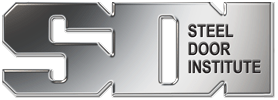Codes & Standards Applicable to Steel Doors & Frames
There are many codes and standards that impact the steel door industry, from building codes used during design and construction, to fire codes which help to ensure safety of building occupants throughout the life of the building. Referenced standards include detailed requirements on various topics such as fire doors, accessibility, windstorm, or energy conservation and sustainability.
Codes and standards must be adopted by the state or local jurisdiction in order for them to be enforceable. In many cases, a state or local jurisdiction will add modifications to the model code or standard, which must be met in addition to the base document.
The table below contains codes that apply to steel doors & frames and have been adopted throughout the United States.
Note: This webpage does not include regional codes, such as the Florida Building Code. The International Code Council (ICCsafe.org) has an interactive map leading to state-by-state code adoptions and contact information for government code officials.
| Body | Codes | Summary | Category |
|---|---|---|---|
| ANSI/BHMA A156.115 Hardware Preparation in Steel Doors or Steel Frames | Covers all significant dimensional attributes for mounting common hardware products in steel doors and frames. | Referenced Standard | |
| American Society of Heating, Refrigerating and Air-Conditioning Engineers | ASHRAE Standard 90.1 Energy Standard for Buildings Except Low-Rise Residential Buildings | A benchmark for commercial building energy codes. | Energy Efficiency |
| Federal Emergency Management Agency | FEMA P-320 Taking Shelter From The Storm | Offers best practices on the design and construction of residential safe rooms, but FEMA does not regulate construction. | Windstorm |
| Federal Emergency Management Agency | FEMA P-361 Safe Rooms for Tornadoes and Hurricanes | Offers best practices on the design and construction of community safe rooms. | Windstorm |
| International Code Council | IBC International Building Code | Provides structural, fire, and life safety provisions for all buildings except detached one- and two-family dwellings and townhouses up to three stories. The IBC is used as the base code for many states, often with state modifications which must be referenced in addition to the IBC. | Building / Fire Code |
| International Code Council | ICC 500 Standard for the Design and Construction of Storm Shelters | The standard for the design and construction of storm shelters. ICC 500 is referenced by the IBC for requirements specific to storm shelters required in certain occupancy types. | Windstorm |
| International Code Council | IECC International Energy Conservation Code | Addresses the design of energy-efficient building envelopes through requirements emphasizing performance. | Energy Conservation / Sustainability |
| International Code Council | IFC International Fire Code | Provides provisions for protection for public health, safety and welfare from the hazards of fire, explosion or dangerous conditions in buildings, structures and premises. | Building / Fire Code |
| ICC/ANSI A117.1 Accessible and Usable Buildings and Facilities | Contains technical criteria to allow people with physical disabilities to independently get to, enter, and use a site, facility, building, or element. A117.1 is the accessibility standard referenced by the IBC, IFC, and NFPA 101. | Accessibility | |
| International Code Council | IgCC International Green Construction Code | Contains sustainability measures for the entire construction project and its site. Its purpose is to make buildings more efficient and reduce waste. | Energy Conservation / Sustainability |
| National Fire Protection Association | NFPA 1 Fire Code | Addresses fire and life safety as well as property protection. | Building / Fire Code |
| National Fire Protection Association | NFPA 80 Standard for Fire Doors and Other Opening Protectives | Regulates the installation and maintenance of assemblies and devices used to protect openings in walls, floors, and ceilings against the spread of fire and smoke within, into, or out of buildings. NFPA 80 is referenced by all of the model codes for requirements specific to fire door assemblies. | Referenced Standard |
| National Fire Protection Association | NFPA 101 Life Safety Code | Provides strategies to protect building occupants in new and existing buildings, addressing building construction, protection, and occupancy features that minimize the effects of fire and related hazards. | Building / Fire Code |
| National Fire Protection Association | NFPA 105 Standard for the Installation of Smoke Doors and Other Opening Protectives | Addresses the installation, maintenance, and testing of smoke door assemblies and smoke dampers that are used to restrict the movement of smoke through openings. Model codes refer to NFPA 105 for requirements specific to smoke door assemblies. | Referenced Standard |
| National Fire Protection Association | NFPA 5000 Building Construction and Safety Code | Provides requirements for those construction, protection, and occupancy features necessary to safeguard life, health, property, and public welfare and minimize injuries. | Building / Fire Code |
| Process Industry Practices | PIP STC01018 Blast Resistant Building Design Criteria | Generally used for petrochemical and offshore facilities. | Blast |
| US Department of Defense | UFC 4-010-01 Unified Facilities Criteria | Primary specification required for all Department of Defense related construction. | Blast |
| US Department of Justice | Americans With Disabilities Act ADA Standards for Accessible Design | Accessible design standards for compliance with the Americans with Disabilities Act, a federal law prohibiting discrimination and ensuring equal opportunity for people with disabilities. | Accessibility |
| US Department of Housing & Urban Development | Fair Housing Act Fair Housing Accessibility Guidelines | Provides accessibility requirements for design and construction for multi-family housing to protect people from discrimination. | Accessibility |
| US Green Building Council | LEED Green Building Certification Standards | Provides a framework for building a holistic green building. The number of LEED points a project earns determines which of the four levels of certification it earns. | Energy Conservation / Sustainability |
